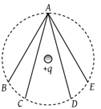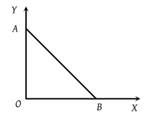Two charged spheres of radii 10 cm and 15 cm are connected by a thin wire. No current will flow, if they have -
1. The same charge on each
2. The same potential
3. The same energy
4. The same field on their surfaces
In the electric field of a point charge q, a certain charge is carried from point A to B, C, D and E. Then the work done

1. Is least along the path AB
2. Is least along the path AD
3. Is zero along all the paths AB, AC, AD and AE
4. Is least along AE
A conductor with a positive charge:
| 1. | is always at +ve potential. |
| 2. | is always at zero potential. |
| 3. | is always at negative potential. |
| 4. | may be at +ve, zero or –ve potential. |
On rotating a point charge having a charge \(q\) around a charge \(Q\) in a circle of radius \(r,\) the work done will be:
| 1. | \(q \times2 \pi r\) | 2. | \(q \times2 \pi Q \over r\) |
| 3. | zero | 4. | \(Q \over 2\varepsilon_0r\) |
If a charged spherical conductor of radius 10 cm has potential V at a point distant 5 cm from its centre, then the potential at a point distant 15 cm from the centre will be -
1.
2.
3.
4. 3 V
The ratio of momenta of an electron and an -particle which are accelerated from rest by a potential difference of 100 volt is
1. 1
2.
3.
4.
| 1. | \(V \neq 0 \text { and } \vec{E} \neq 0\) |
| 2. | \(V \neq 0 \text { and } \vec{E}=0\) |
| 3. | \(V=0 \text { and } \vec{E}=0\) |
| 4. | \(V=0 \text { and } \vec{E} \neq 0\) |
A proton is about 1840 times heavier than an electron. When it is accelerated by a potential difference of 1 kV, its kinetic energy will be -
1. 1840 keV
2. 1/1840 keV
3. 1 keV
4. 920 keV
As per this diagram a point charge +q is placed at the origin O. Work done in taking another point charge –Q from the point A [co-ordinates (0, a)] to another point B [co-ordinates (a, 0)] along the straight path AB is

1. Zero
2.
3.
4.
The capacity of a condenser is 4 × 10–6 farad and its potential is 100 volts. The energy released on discharging it fully will be -
1. 0.02 Joule
2. 0.04 Joule
3. 0.025 Joule
4. 0.05 Joule






